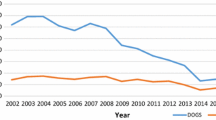Abstract
In the present study, total of 32 ante-mortem (AM) samples (saliva = 18 and corneal smears = 14) from six animal species (cattle = 5; camel = 1; goat = 1; horse = 1; buffalo = 4; dog = 6) and 28 post-mortem (PM) samples of domestic (cattle = 6; camel = 1; goat = 1; buffalo = 5; dog = 7) and wild animals (lion = 4, mongoose = 2; bear = 1; leopard = 1) were examined for rabies diagnosis in Gujarat, India. Direct fluorescent antibody test (dFAT) and reverse transcriptase polymerase chain reaction (RT-PCR) were applied on AM samples, whereas along with dFAT and RT-PCR, histopathological examination, immunohistochemistry (IHC) and real time PCR (qPCR) were used for PM diagnosis. Nucleotide sequencing of full nucleoprotein (N) and glycoprotein (G) genes were carried out upon representative amplicons. In AM examination, 7/18 saliva and 5/14 corneal impressions samples were found positive in dFAT and 8/18 saliva samples were found positive in RT-PCR. In PM examination, 14/28 samples showed positive results in dFAT and IHC with unusual large fluorescent foci in two samples. In histopathology, 11/28 samples showed appreciable lesion and Negri bodies were visible in 6 samples, only. Out of 23 brain samples examined. 12 samples were found positive in N gene RT-PCR and qPCR, and 10 samples in G gene RT-PCR. Phylogenetic analysis of N gene revealed that test isolates (except sample ID: lion-1; lion, Gir) form a close group with sequence ID, KM099393.1 (Mongoose, Hyderabad) and KF660246.1 (Water Buffalo, Hyderabad) which was far from some south Indian and Sri Lankan isolates but similar to Indian isolates from rest of India and neighboring countries. In G gene analysis, the test isolates form a close group with sequence ID, KP019943.1.





Similar content being viewed by others
References
Nagarajan T, Nagendrakumar SB, Mohanasubramanian B et al (2009) Phylogenetic analysis of nucleoprotein gene of dog rabies virus isolates from Southern India. Infect Genet Evol 9:976–982. https://doi.org/10.1016/j.meegid.2009.04.004
Manjunatha Reddy GB, Krishnappa S, Vinayagamurthy B et al (2018) Molecular epidemiology of rabies virus circulating in domestic animals in India. VirusDisease 29:362–368. https://doi.org/10.1007/s13337-018-0478-9
Meslin FX, Kaplan, Martin M, Koprowski H (1973) Laboratory techniques in rabies. World Health Organization: Monograph series no 23
Wacharapluesadee S, Hemachudha T (2002) Urine samples for rabies RNA detection in the diagnosis of rabies in humans. Clin Infect Dis 34:874–875. https://doi.org/10.1086/338872
Singh CK, Ahmad A (2018) Molecular approach for ante-mortem diagnosis of rabies in dogs. Indian J Med Res 147:513–516. https://doi.org/10.4103/ijmr.IJMR_1705_15
Nagarajan T, Mohanasubramanian B, Seshagiri EV et al (2006) Molecular epidemiology of rabies virus isolates in India. J Clin Microbiol 44(9):3218–3224. https://doi.org/10.1128/jcm.00801-06
Reddy GBM, Singh R, Singh KP et al (2019) Molecular epidemiological analysis of wild animal rabies isolates from India. Vet World 12:352–357. https://doi.org/10.14202/vetworld.2019.352-357
Cherian S, Singh R, Singh KP et al (2015) Phylogenetic analysis of Indian rabies virus isolates targeting the complete glycoprotein gene. Infect Genet Evol 36:333–338. https://doi.org/10.1016/j.meegid.2015.09.024
Suvarna SK, Layton C, Bancroft JD (2013) Bancroft’s theory and practice of histological techniques. Elsevier, Churchill Livingstone
Singh NK, Meshram CD, Sonwane AA et al (2014) Protection of mice against lethal rabies virus challenge using shortinterfering RNAs (siRNAs) delivered through lentiviral vector. Mole Biotechnol 56:91–101. https://doi.org/10.1007/s12033-013-9685-1
Gupta PK, Rai A, Rai N et al (2005) Immunogenicity of a plasmid DNA vaccine encoding glycoprotein gene of rabies virus CVS in mice and dogs. J Immunol Immunopathol 7:58–61
Kumar S, Stecher G, Tamura K (2016) MEGA7: molecular evolutionary genetics analysis version 7.0 for bigger datasets. Mol Biol Evol 33:1870–1874. https://doi.org/10.1093/MOLBEV/MSW054
Sudarshan MK, Madhusudana SN, Mahendra BJ et al (2007) Assessing the burden of human rabies in India: results of a national multi-center epidemiological survey. Int J Infect Dis 11:29–35. https://doi.org/10.1016/j.ijid.2005.10.007
Gill GS, Singh BB, Dhand NK et al (2019) Estimation of the incidence of animal rabies in Punjab, India. PLoS ONE. https://doi.org/10.1371/journal.pone.0222198
Singh BB, Gajadhar AA (2014) Role of India’s wildlife in the emergence and re-emergence of zoonotic pathogens, risk factors and public health implications. Acta Trop 138:67–77. https://doi.org/10.1016/j.actatropica.2014.06.009
Reddy RVC, Mukherjee F, Rana SK et al (2015) Rabies virus infection in domestic buffaloes and wild animals in India. J Adv Vet Res 5:68
Rupprecht CE, Hanlon CA, Hemachudha T (2002) Rabies re-examined. Lancet Infect Dis 2:327–343. https://doi.org/10.1016/S1473-3099(02)00287-6
Nagaraj T, Vasanth JP, Desai A et al (2006) Ante mortem diagnosis of human rabies using saliva samples: comparison of real time and conventional RT-PCR techniques. J Clin Virol 36:17–23. https://doi.org/10.1016/j.jcv.2006.01.009
Sharma P, Singh CK, Sood NK et al (2014) Diagnosis of rabies from brain: comparison of histochemical and histopathological approaches. Indian J Vet Pathol 38:269. https://doi.org/10.5958/0973-970x.2014.01190.0
Dürr S, Naïssengar S, Mindekem R et al (2008) Rabies diagnosis for developing countries. PLoS Negl Trop Dis. https://doi.org/10.1371/journal.pntd.0000206
Achkar SM, Fernandes ER, Carrieri ML et al (2010) Sensitivity of the Immunohistochemistry technique in central nervous system fragments of cattle and horses naturally infected by rabies virus. Pesqui Vet Bras 30:211–218. https://doi.org/10.1590/s0100-736x2010000300004
Whitfield SG, Fekadu M, Shaddock JH et al (2001) A comparative study of the fluorescent antibody test for rabies diagnosis in fresh and formalin-fixed brain tissue specimens. J Virol Methods 95:145–151. https://doi.org/10.1016/S0166-0934(01)00304-4
Biswal M, Ratho RK, Baijayantimala M (2012) Role of reverse transcriptase polymerase chain reaction for the diagnosis of human rabies. Indian J Med Res 135:837
Dantas JVJ, Kimura LMS, Ferreira MSR et al (2004) Reverse transcription-polymerase chain reaction assay for rabies virus detection. Arq Bras Med Vet Zootec 56:398–400. https://doi.org/10.1590/s0102-09352004000300017
Dandale M, Singh CK, Sandhu BS et al (2012) Intravitam diagnosis of rabies from saliva by nested RT-PCR. IOSR J Agric Vet Sci 1:8–11. https://doi.org/10.9790/2380-0110811
Nagarajan T, Rupprecht CE, Dessain SK et al (2008) Human monoclonal antibody and vaccine approaches to prevent human rabies. In: Dessain SK (ed) Human antibody therapeutics for viral disease. Current topics in microbiology and immunology, vol 317. Springer, Berlin, Heidelberg. https://doi.org/10.1007/978-3-540-72146-8_3
Jiao W, Yin X, Li Z et al (2011) Molecular characterization of China rabies virus vaccine strain. Virol J. https://doi.org/10.1186/1743-422X-8-521
Patel AC, Upmanyu V, Ramasamy S et al (2015) Molecular and immunogenic characterization of BHK-21 cell line adapted CVS-11 strain of rabies virus and future prospect in vaccination strategy. Virus Disease 26:288–296. https://doi.org/10.1007/s13337-015-0285-5
Reddy GBM, Singh R, Singh RP et al (2011) Molecular characterization of Indian rabies virus isolates by partial sequencing of nucleoprotein (N) and phosphoprotein (P) genes. Virus Genes 43:13–17. https://doi.org/10.1007/s11262-011-0601-0
Acknowledgements
The authors are highly thankful to all the concern officers of the Forest Department, GoG, Gujarat for submission of wildlife samples and Dr. D. V. Joshi, Principal and Dean, College of Veterinary Science & AH, SDAU, SK Nagar for his kind support throughout the study.
Author information
Authors and Affiliations
Contributions
MGP: sample collection, most of laboratory work (as Post graduate student); ACP: conceptualization of study and FAT, RT-PCR, data analysis (as major advisor); SHR: immunohistochemistry and pathological examination; KKS: data analysis, manuscript preparation; SSP: sample collection, RT-PCR; HCC: overall supervision of the study; RSP: pathological examination; MDS: FAT; HNV: sample collection from wild animals at Gir; JB: sample collection from wild animals at Banaskantha; SKM: sequencing and phylogenetic analysis.
Corresponding author
Ethics declarations
Conflict of interest
The authors declare no conflicts of interest.
Additional information
Publisher's Note
Springer Nature remains neutral with regard to jurisdictional claims in published maps and institutional affiliations.
Supplementary Information
Below is the link to the electronic supplementary material.
Rights and permissions
Springer Nature or its licensor (e.g. a society or other partner) holds exclusive rights to this article under a publishing agreement with the author(s) or other rightsholder(s); author self-archiving of the accepted manuscript version of this article is solely governed by the terms of such publishing agreement and applicable law.
About this article
Cite this article
Patel, M.G., Patel, A.C., Raval, S.H. et al. Ante-mortem and Post-mortem Diagnosis Modalities and Phylogenetic Analysis of Rabies Virus in Domestic and Wild Animals of Gujarat, India. Indian J Microbiol 63, 645–657 (2023). https://doi.org/10.1007/s12088-023-01126-0
Received:
Accepted:
Published:
Issue Date:
DOI: https://doi.org/10.1007/s12088-023-01126-0




